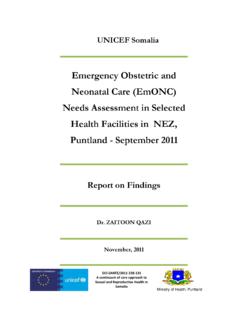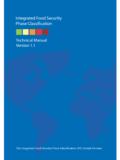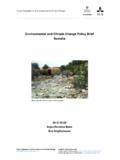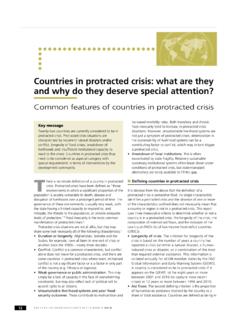Transcription of Regional Mixed Migration in the Horn of Africa and …
1 quarter 2 2016. Regional Mixed Migration in the Horn of Africa and Yemen in 2016: 2nd quarter trend summary and analysis Mixed Migration movements were increasingly numerous and complex in the second quarter of 2016. Migration along the northward, eastward and westward routes all showed an increase in numbers, with migrants and refugees being motivated to move by ongoing conflict, political oppression and a lack of opportunities. Internal and cross border displacement in Yemen, South Sudan and surrounding countries also increased, while a pledge to close Dadaab refugee camp in Kenya has generated uncertainty about the protection of hundreds of thousands of Somali refugees. Irregular Movement from the Horn Northward (through Egypt into Israel). Movements this quarter were characterised by an increasing number of migrants and asylum seekers from the Horn of Africa arriving in Egypt and using the country as a gateway for further travel across the Mediterranean Sea towards Europe.
2 A media report in May 2016, highlighted a growing number of Eritrean nationals, and a sizeable number of Somalis, Sudanese and Ethiopians in Cairo hoping to depart from the Egyptian coast. It appears that the migrants and asylum seekers are using Egypt to circumvent the precarious security situation in Libya, and reported round-ups and deportations occurring in Khartoum, Sudan. Instead, some migrants choose to travel through the eastern part of Sudan and avoid Khartoum, on their way to Egypt. The sea route from Egypt to Europe is also increasingly being used by Egyptian nationals, who made up 5. percent of arrivals in Italy between April and June 2016. In a continued committal to crack down on irregular departures from Egyptian shores, media reports documented the interception of 331 migrants (including Sudanese, Eritrean, Somali, Ethiopian, and Egyptian nationals, amongst others) by Egypt's naval forces in June. The migrants were apprehended aboard three boats which were attempting to depart from Egypt's Alexandria port towards Italy.
3 Egypt's National Coordinating Committee on Preventing and Combating Illegal Migration stated that Egyptian border guards had managed to stop 5,076 between April and July 2016. Migration into Israel remained limited as security surveillance at the border wall between Egypt and Israel continued to prevent asylum seekers and migrants from entering the country. However, in a positive outcome for refugee protection, Israel granted refugee status to an asylum seeker of Sudanese origin for the first time ever. Figures from the government's Population, Immigration and Borders Agency (PIBA) show that between 2009 and the beginning of 2015, Israel has granted asylum to only 4. Eritrean nationals (out of 2,408 applications) and none to Sudanese nationals (of 3,165 applications). Mutasim Ali's application was the first of its kind to be accepted by the government. Despite optimism shared by Ali and his lawyers, a spokesperson for the Interior Ministry stated that this is not part of a mass effort by the government to offer protection to the approximately 45,000 migrants and asylum seekers of Eritrean and Sudanese origin in Israel.
4 quarter 2 2016. Eastward (towards Yemen). Movements between the Horn of Africa and Yemen continued to be characterised by a bi-directional flows, both from the Horn to Yemen and from Yemen to the Horn. Enduring conflict also continued to result in the displacement of persons within the country. At the end of June 2016 there were 2,818,072 internally displaced persons in the country, a slight increase on the more than million that were displaced at the end of the first quarter of 2016, and more than one in ten of the total Yemeni population. As of 30 June 2016, a total of 87,417 persons (including 30 percent Yemeni nationals and 36 percent Somali nationals) had sought refuge in neighbouring countries in the Horn of Africa since the outbreak of conflict in March 2015. The pace of arrivals in the Horn this quarter continued to show a downward trend, with only 2,353 persons arriving between April and June, a 60 percent decline from the first quarter .
5 Aside from arrivals recorded in March 2015, this quarter has the lowest arrival figures on record. The increasing number of internal displacements in Yemen may point towards a preference among Yemenis to relocate to safer areas within the country than to seek safety outside the country. Yemen's Taskforce on Population Movement confirmed that 800,000 IDPs had been tracked as having returned to or within 19 governorates as at the end of May 2016. Arrivals from Yemen into the Horn of Africa 60,000. 50,468. 50,000. 40,000. 30,000. 17,938. 20,000. 8,908. 10,000 5,947. 1,798 2,353. 0. Mar Apr-Jun Jul-Sep Oct-Dec Jan-Mar Apr-Jun 2015 2015 2015 2015 2016 2016. Figure 1: Arrivals from Yemen into the Horn of Africa Data source: UNHCR. The warring factions in the country failed again to hold successful peace negotiations, with the talks between the government and Houthi rebels being postponed indefinitely. An agreement on the cessation of hostilities appears to have taken hold in around 80-90 percent of the country, but remains precarious, with sporadic violence being reported.
6 With no political solution yet agreed, it is likely that the displacement trend will continue into the next quarter . Conflict continues to do little to deter migrants and refugees from the Horn of Africa from travelling to Yemen (and beyond), in search of protection and economic opportunity. At least 35,453 persons (87. percent Ethiopian, 13 percent Somali) travelled from Obock in Djibouti, and from coastal towns near Bossaso in Puntland to Yemen this quarter . This represents a 23 percent increase on arrival figures recorded in the first quarter of 2016, and a significant 338 percent increase on arrivals recorded during quarter 2 2016. the same period in 2015. 14,373 persons arrived in June alone, which is the highest monthly arrival figure registered since records began in 2006. The spike in number coincided with the holy month of Ramadan and it is likely that this spurred a perception amongst migrants and refugees that the border crossing between Yemen and Saudi Arabia (a popular destination country for the majority transiting through Yemen) would be easier to navigate.
7 As with the first quarter this year, and movements in 2015, migrants and asylum seekers preferred to depart from coastal shores close to Bossaso rather than from Obock. 84 percent of journeys were made along the Arabian Sea with only 16 percent using the Red Sea. Continued abuses (see Migrant Vulnerabilities below) and the presence of military patrols along the Red Sea are believed to contribute to the declined use of the Red Sea route. Migrant and Refugee Arrivals in Yemen, Q2 2015-2016. 16,000. 2,145. 14,000. 12,000 1,918. 1,509. 10,000. 8,000. 6,000 12,228. 594 9,327. 4,000 8,326. 392 122. 2,000 3,466. 1,602 1,922. 0. 2015 2016 2015 2016 2015 2016. April May June Arabian Sea Red Sea Figure 2: Migrant and Refugee Arrivals in Yemen, Q2 2015-2016. Source: UNHCR and RMMS. Southward (through Kenya towards South Africa ). Typical of journeys made south, migrants and asylum seekers from the Horn of Africa continued to face risks of detention and deportation as they move irregularly along the eastern corridor towards South Africa .
8 According to media reports, 119 Ethiopian nationals were detained in Malawi in May for illegal entry into the country and for travelling without documents. In the same month, IOM supported the repatriation of 14 unaccompanied child migrants to return from Zambia to Ethiopia. The children, aged between 12 and 17 years, were intercepted by Zambian police while attempting to cross into South Africa and were detained for several months before being released. Detention is frequently used as an immigration measure in southern African countries, where the government does not have the finances required to deport migrants back to their country of origin. quarter 2 2016. Every year thousands of Ethiopian nationals irregularly migrate from Ethiopia, through Kenya, Tanzania, Malawi and Mozambique en route to South Africa . Figures from 2009 suggest that between 17,000 and 20,000 Somali and Ethiopian migrants are smuggled towards South Africa every year, with Ethiopian national accounting for at least two thirds of the estimates.
9 While the number of undocumented migrants from other African countries crossing into South Africa is unknown, conservative estimates place this number anywhere between three and six million people. Westward (also known as the Central Mediterranean route'). This quarter a total of 16,369 migrants and refugees from the Horn of Africa (Eritrea, Ethiopia, Somalia and Sudan) arrived in Italy via the Central Mediterranean, making up 32 percent of all arrivals along that route. The upward trend in arrivals among Horn of Africa nationals noted at the end of the last quarter , appears to have been sustained during this quarter , with arrivals between April and June accounting for a significant 415 percent increase from arrivals between January and March. The biggest climbs were noted amongst Eritreans (1,233 percent), followed by Sudanese (455 percent), Ethiopians (350 percent) and Somalis (73 percent). A surge in movements in the second quarter of the year is characteristic of patterns witnessed in 2015 (and 2014) and is often correlated with better weather conditions.
10 Nonetheless, arrival figures are yet to be on par with those recorded during the second quarter of 2015. (27,970 persons) and this is most apparent amongst Eritrean nationals. Eritrean arrivals in Italy this quarter dropped 54 percent when compared to the same quarter in 2015, and 53 percent when comparing the first six months of 2016 to the same period in 2015. If unconfirmed anecdotal evidence received by RMMS last quarter holds true, then there are a large number of Eritrean migrants and refugees currently lying in wait in Khartoum, Sudan waiting for their opportunity to continue their journey north. Moreover, in May 2016, Human Rights Watch reported on the deportation of 442. Eritrean nationals (including six registered refugees) from Sudan back to Eritrea, which may have had an impact on movements towards Europe. The reported deployment of Sudanese forces to the remote desert on the Sudan-Libya border may have also contributed to a reduction in persons using this route.



